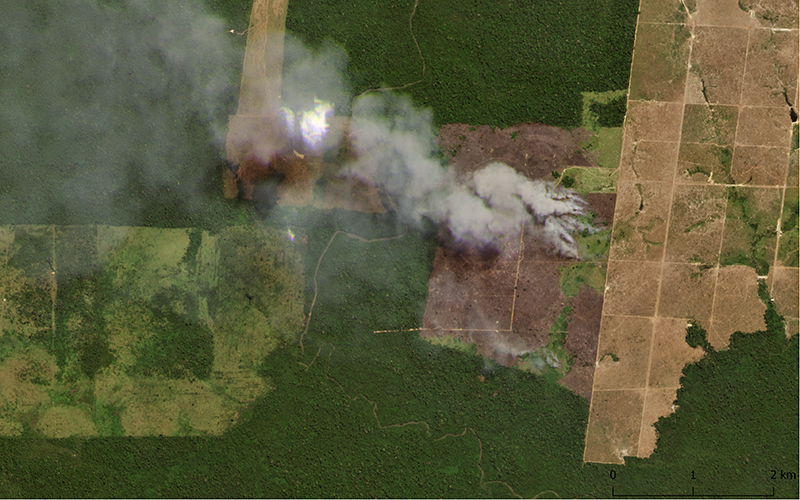PHOENIX – Fires burn every year in the Amazon rainforest of Brazil, but this year’s fires have gained enormous attention because of the large number and size of the fires compared with past years. And that has touched off a slew of misinformation – some of it willful.
More than 100,000 fires have erupted in the Brazilian Amazon this year, according to the Brazilian National Institute for Space Research, and although the fires have burned more intensely than past years, the number of fires in 2004 were much greater, reaching more than 185,000. Many of the fires, which this year have burned an area three times the size of Arizona, are thought to have been caused by ranchers and farmers clearing land for cattle and crops.
David Pearson, a research professor in Arizona State University’s School of Life Sciences, has been working in the Amazon since 1968, and the many books about tropical bird species on his shelf and a pin of a bird on his hat signify the passion he has for the rainforest.
Pearson said he’s never seen fires as extensive as those this year, and there are global, regional and local impacts of these fires.
“On a global scale, those fires are pushing so much more carbon dioxide into the atmosphere, so it’s going to affect everyone around the world,” he said.
The importance of the Amazon
In addition to storing vast amounts of carbon dioxide, the Amazon is home to about 390 billion trees and more than 16,000 plant species, as well as millions of animal species. About 30 million people live in the Amazon, and many millions more depend on it.
Although there are important reasons to protect rainforests, claims made on social media about the Amazon being the “lungs of the Earth” are inaccurate.
Covering 2.2 million square miles, the Amazon is the world’s largest tropical rainforest. It spans several other South American countries, but the majority is in Brazil. It produces oxygen as a byproduct of photosynthesis, Pearson said, but it uses most of that oxygen through a process called respiration.
“Most of our oxygen comes from the phytoplankton in the ocean, and that’s something that people need to keep in mind,” he said. “The really important factor is the carbon dioxide.”
Susanne Neuer, a professor in the ASU School of Life Sciences who specializes in marine biogeochemistry and plankton ecology, said phytoplankton, or microscopic algae, also produces oxygen through photosynthesis.
“Phytoplankton, like all plants, have this dual function,” Neuer said. “They take up CO2, which is important because we’re putting out so much CO2 into the atmosphere, and they produce oxygen, but those processes are connected.”
Oxygen in the air comes from an interruption in phytoplankton’s photosynthesis cycle involving a process that occurs over millions of years, which allows the oxygen to accumulate to levels useful for the atmosphere.
“Most people just don’t realize, they look at the ocean and see blue water, and they don’t think that there’s tens of thousands of cells in each milliliter,” Neuer said. “It’s very small volume, but there’s a lot of organisms in there that all do very important things.”
False claims
From environmentalists to politicians, false claims have been made about the Amazon producing 20% of the world’s oxygen, and some of the most viral photos of the events have been discovered to be of fires from previous years or fires burning outside the Amazon.
Environmental activist and actor Leonardo DiCaprio recently shared a fire photo on Instagram that had been taken in 2017, and French President Emmanuel Macron shared a photo on Twitter that was taken by photographer Loren McIntyre, who died in 2003.
Our house is burning. Literally. The Amazon rain forest – the lungs which produces 20% of our planet’s oxygen – is on fire. It is an international crisis. Members of the G7 Summit, let's discuss this emergency first order in two days! #ActForTheAmazon pic.twitter.com/dogOJj9big
— Emmanuel Macron (@EmmanuelMacron) August 22, 2019
Although it’s critical to help people understand the importance of conserving rainforests, it’s also essential to differentiate facts from hype.
Now, a company called Planet can capture satellite images of the fires almost in real time, making it easier to detect social media images that falsely claim to show Amazon fires from 2019.
Planet, which was founded by three NASA scientists in 2010, partnered with multiple ASU affiliates, including the ASU Center for Global Discovery and Conservation Science, in 2019. The Planet Incubator Program allows ASU students and faculty members to utilize the data to incorporate into their projects at no cost. The public can access the data for a fee.
Megs Seeley, a graduate teaching assistant in the Center for Global Discovery, said Planet is unique because of its daily coverage of the globe.
“Planet has the higher resolution both temporally and spatially that if you integrate it with artificial intelligence you can start to get a better idea of what’s going on in the Amazon and be able to monitor it in real time, versus once a half month, or maybe once a month,” Seeley said.
The San Francisco-based company launched its first satellite in 2013 and has about 140 satellites circling the planet now, according to its website.
The incubator program provides the ability to use satellite imagery from anywhere on the planet through a constellation of small satellites in low Earth orbit, which assist in many different industries, including forestry and land use, emergency management, and mapping and geographic information systems.

Thanks to a partnership between Arizona State University and the company Planet, students, faculty and researchers at ASU can access high-resolution satellite imagery in real time. (Image courtesy of Planet Lab Inc. and CGDCS.)
Ovidiu Csillik, a postdoctoral research scholar for the Center for Global Discovery and Conservation Science, said the data from Planet are in higher resolution than a larger satellite, such as Landsat, would provide.
“After looking at the images and seeing what’s happening,” he said, “then you can go further and apply all kinds of advanced techniques in order to get statistics out of it, and then our ultimate scope is to provide a science that is actionable.”
Kai Shu, a Ph.D. candidate in ASU’s department of computer science and engineering, published the book “Detecting Fake News on Social Media” with his adviser, Professor Huan Liu.
Because social media is not fact-checked in the same way that traditional news media is, social media has contributed to the proliferation of misinformation and made it easier to spread.
“I think the Amazon forest example is a great example that can show the challenge that can come from the text itself, because people can write anything they want, and they try to mimic true news,” Shu said. “And the image is even harder, because the image can be true images.”

There’s a lot of misinformation about the thousands of fires burning in the Brazilian Amazon this year. (Photo by Joao LAET/AFP/Getty Images)
There are some characteristics to recognize to avoid false information, Shu said. For example, you can use reverse image searching through Google or other applications to discover the source of an image and other places it may appear online.
Change is inevitable, Pearson said, but things can be done to anticipate the changes, such as using climate models to understand and mitigate the impacts.
“Even here in Arizona, we touch the rainforest every day, in the foods we eat, the furniture we sit in, the medicines we use, and understanding that we have just begun to tap into the usefulness of these organisms …” Pearson said. “(There is) the possibility that all these things are going to be gone before we have a chance to show the benefits they could have for us here in Arizona.”
Video by Jordan Elder/Cronkite News
